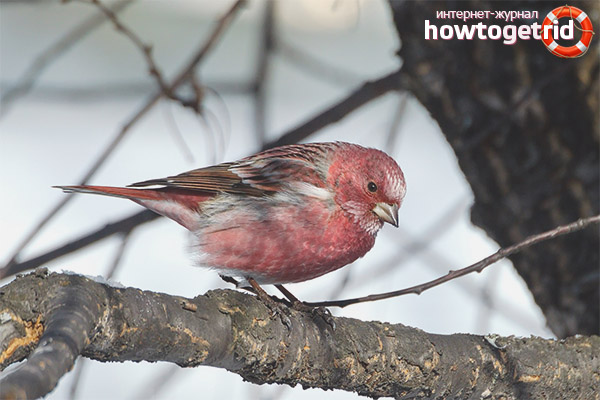The content of the article
Siberian lentils, like most birds of this species, have a short and sharp beak, the length of which does not exceed 12 millimeters. They belong to the family finch, which are classified as a passerine. The tail of these birds is different in length, a distinctive notch is visible at the tail section, the wing part of their wing consists of 4 feathers, and the fourth is small in size. The total body length of the bird is 170 millimeters, and the width of the wingspan reaches 278 millimeters.
Description
In flight, lentils, like most representatives of the family finch, use a non-linear trajectory. In addition, they are distinguished by a noticeable tail length and a pink-crimson color of the plumage of males that attracts attention. Siberian lentils also differ from other birds of this species by the presence of pink shades in the color of females. To move on the ground he uses his fingers for short jumps.
As a call signal, lentils use a quiet intermittent whistle, reminiscent of the tone of the king's signal. She spends most of her time silently, but she accompanies the rare moments of her singing with theatrical performances. Lentils, issuing a melodic whistle, spreads its wings and draws its head in when the singing breaks off, it shakes its wings and tail, freezing in this position.
The main shade of the plumage of a female Siberian lentil consists of a pale brown color with characteristic dark patches throughout the upper body. Its middle part of the abdomen, the area of the undertail and the inner part of the wings are whitish in color. The female’s loin is pink and her entire body is covered with a light pink coating that resembles a view through pink glass.
The iris of these birds is dark brown in color, their beak is colored yellow-brown with a dark end, their legs are also painted yellow-brown. The coloration of young individuals in general resembles the coloring of females, but is characterized by more dull tones.
Habitat
This species of birds was widely distributed in the middle and eastern parts of Siberia. Siberian lentils can also be found in the middle part of the Lower Tunguska and in the mountainous region of northern Baikal. Nests of these birds are found on Sakhalin, in the Sayan Mountains and the northwestern regions of Altai; in addition, it is found in Mongun-Taiga and in some areas of Tanu-Ola.
In winter, these birds live in most regions of Altai, the northern outskirts of Mongolia, on the territory of Transbaikalia, on the Amur coasts, in the regions of the Ussuri Territory, and in some regions of China located north of Shansi. There were cases when this bird was met in Japan.
Diet
The main diet of Siberian lentils consists of grain of wild-growing and selective cereal crops, seeds of various plants, both trees, shrubs and grasses. In addition, lentils use all kinds of berries and young cedar sprouts as food.
Offspring
Many facts about the life of these birds are still unknown. No one had to meet the places in which these birds make nests, and there is no evidence of the size and structure of the lentil's nest. In addition, to date, there is no information about the nature of the behavior of these birds in the mating season, models of the social structure of life, time of masonry formation, type and size of eggs.
It is known that Siberian lentil chicks are born in the second half of June, and leave their nests closer to mid-July. During this period, young individuals were observed that were quite good at flying, by that time the composition of the brood was already broken and the young individuals were kept alone. This fact was recorded in the region of Lake Oy at the beginning of July 2, and later received confirmation on the Stanovoi Range in the second half of July.











Submit